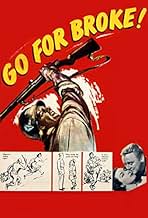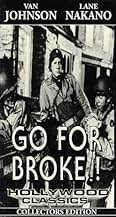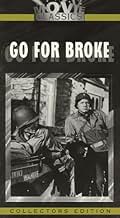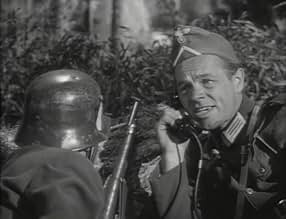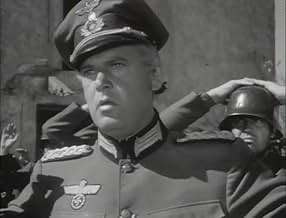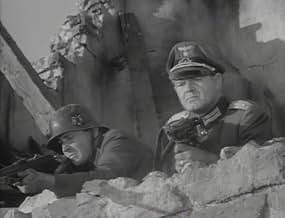Füge eine Handlung in deiner Sprache hinzuThe story of Japanese-American soldiers who fought in Europe during World War II.The story of Japanese-American soldiers who fought in Europe during World War II.The story of Japanese-American soldiers who fought in Europe during World War II.
- Für 1 Oscar nominiert
- 1 Gewinn & 1 Nominierung insgesamt
- Rosina
- (as Gianna Canale)
- Soldier
- (Nicht genannt)
- Lieutenant
- (Nicht genannt)
- Masami's Buddy
- (Nicht genannt)
- Mail Clerk
- (Nicht genannt)
- German Officer
- (Nicht genannt)
- Chaplain
- (Nicht genannt)
Empfohlene Bewertungen
The movie follows the exploits of the 442, the first all-Nisei (Japanese- American) Regimental combat team in WWII. In early 1942, all the Japanese- Americans in California, Seattle, Oregon and Hawaii were uprooted from their homes and put into camps. All the volunteers were from the 10 internment camps throughout the western states. They felt that this was the only way to prove to the U. S. that they were as patriotic as anybody else, in fact most of them were American Citizens! Since they had nothing to lose, but their lives, their motto was "GO FOR BROKE!" and that's what they did. They are today the most decorated battalion in the history of the U.S. military and proved something that they shouldn't have to be proved, that they were Americans!
Van Johnson is used as the "white man" foil, to show how the rest of the country looked at the Japanese-American, and he does a great job. He starts off as a bigot, but as he begins to understand and respect his troops, he becomes one of them. There's a funny scene where one of his men call him "BAKATARE",
which is a curse word close to "Damn, stupid...." and tells him that the soldier is being very polite, he's bowing as he says this. This film has everything: humor, action, great characters and... truth!
That could all be a little too rhetorical for its own good, but Pirosh never over-stresses his point, and his picture is never holier-than-thou. "You see, Sir, I'm from Texas", Grayson says to his superior, but Pirosh lets it go at that and doesn't lash out against Southern bigotry. I really liked the gentle irony of Pirosh' contrasting the idyllic, outdated guidebooks to Italy and France that Grayson reads with the prosaic reality of war-torn countries.
This adversity is personified in the character of Lieutenant Grayson (Van Johnson) - a tall, blond, Texan with a bad attitude about working with what he calls "Japs". Though Grayson's story arc is not really very surprising, it is thoroughly believable. The excellent Oscar-nominated Robert Porash script, solid editing and directing, and Johnson's nice performance make his portrayal of the archetypal understated Texan quite excellent. I can say this because I am a Texas-ex - though you never really get the place out of your heart.
For once, the minority is less stereotyped than the Northern European-American males! The Japanese-American actors are all excellent, and are the real stars of this film.
I agree with the vast majority of reviews published here on IMDb about this significant and entertaining film. Go For Broke is a war film which very nicely explores human behavior, American social reality and ethics but also commemorates and celebrates the triumph of humanity in adverse situations.
Recommended!
While this is not the most exciting war movie ever made, it is certainly worth adding to a collection, especially since it can be bought in a 2-VHS set with "Gung Ho." Of special note is the scene where two German soldiers are trying to make heads-or-tails of of the Japanese chatter on field phone lines they are tapping.
Wusstest du schon
- WissenswertesSeveral of the main characters were played by actual members of the 442nd Regimental Combat Team depicted in the film. The men saw action with the outfit in Italy and France.
- PatzerWhen Lt Grayson formally reports to his regimental commander at Camp Shelby, he performs a complete salute before the commander even begins his. Proper procedure would be for Grayson to bring his salute up, wait for his commander to complete a full salute, then return his arm to his side.
- Zitate
[first title card]
Title Card: "The proposal of the War Department to organize a combat team consisting of loyal American citizens of Japanese descent has my full approval.
[second title card]
Title Card: The principle on which this country was founded and by which it has always been governed is that Americanism is a matter of the mind and heart; Americanism is not, and never was, a matter of race or ancestry."
Title Card: Franklin D. Roosevelt
[third title card]
Title Card: The 442nd Regimental Combat Team and the 100th Infantry Battalion were composed of American citizens of Japanese ancestry.
Title Card: * * *
Title Card: BATTLE RECORD:
Title Card: 7 Major Campaigns in Europe
Title Card: 9,486 Casualties
Title Card: 18,143 Individual Decorations
Title Card: 7 Presidential Unit Citations
[fourth title card]
Title Card: This picture tells part of their heroic story. It starts at Camp Shelby, Mississippi, in 1943...
- VerbindungenEdited into WW II Theater: Go For Broke (2022)
- SoundtracksThe Meaning of Love
Written by Robert Pirosh, Alberto Colombo and Ken K. Okamoto
Top-Auswahl
Details
Box Office
- Budget
- 1.337.000 $ (geschätzt)
- Laufzeit
- 1 Std. 32 Min.(92 min)
- Farbe
- Seitenverhältnis
- 1.37 : 1


